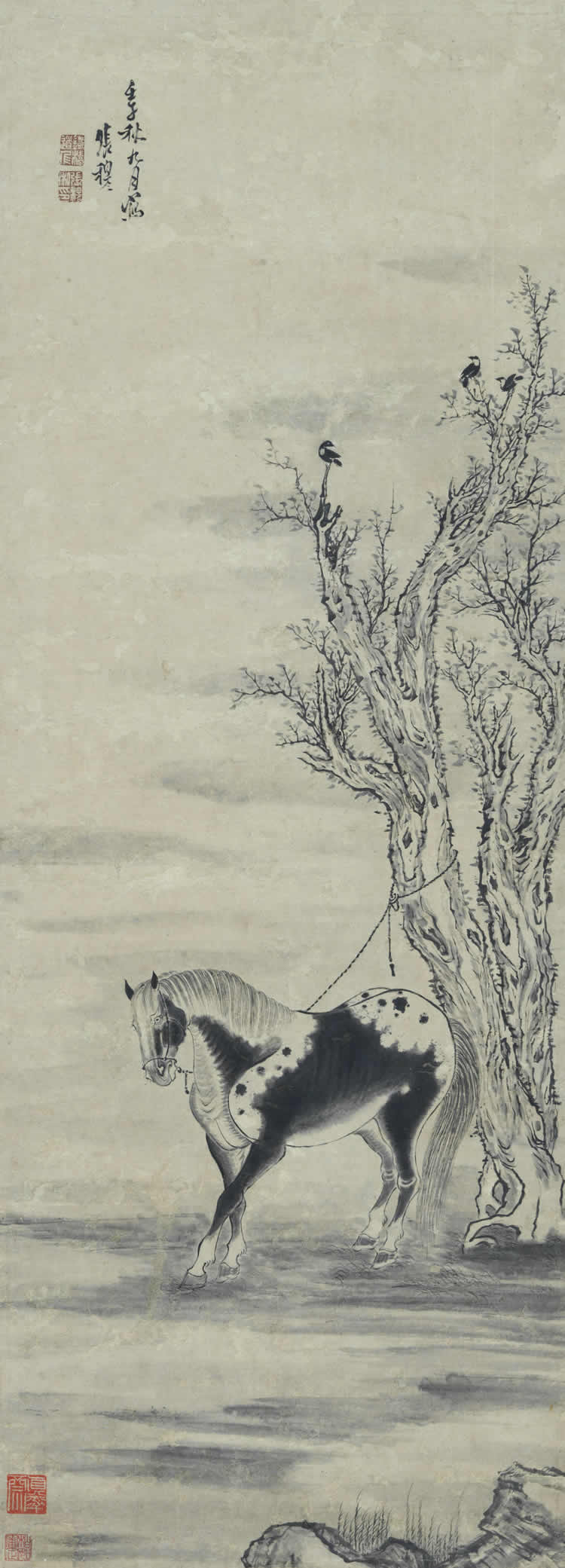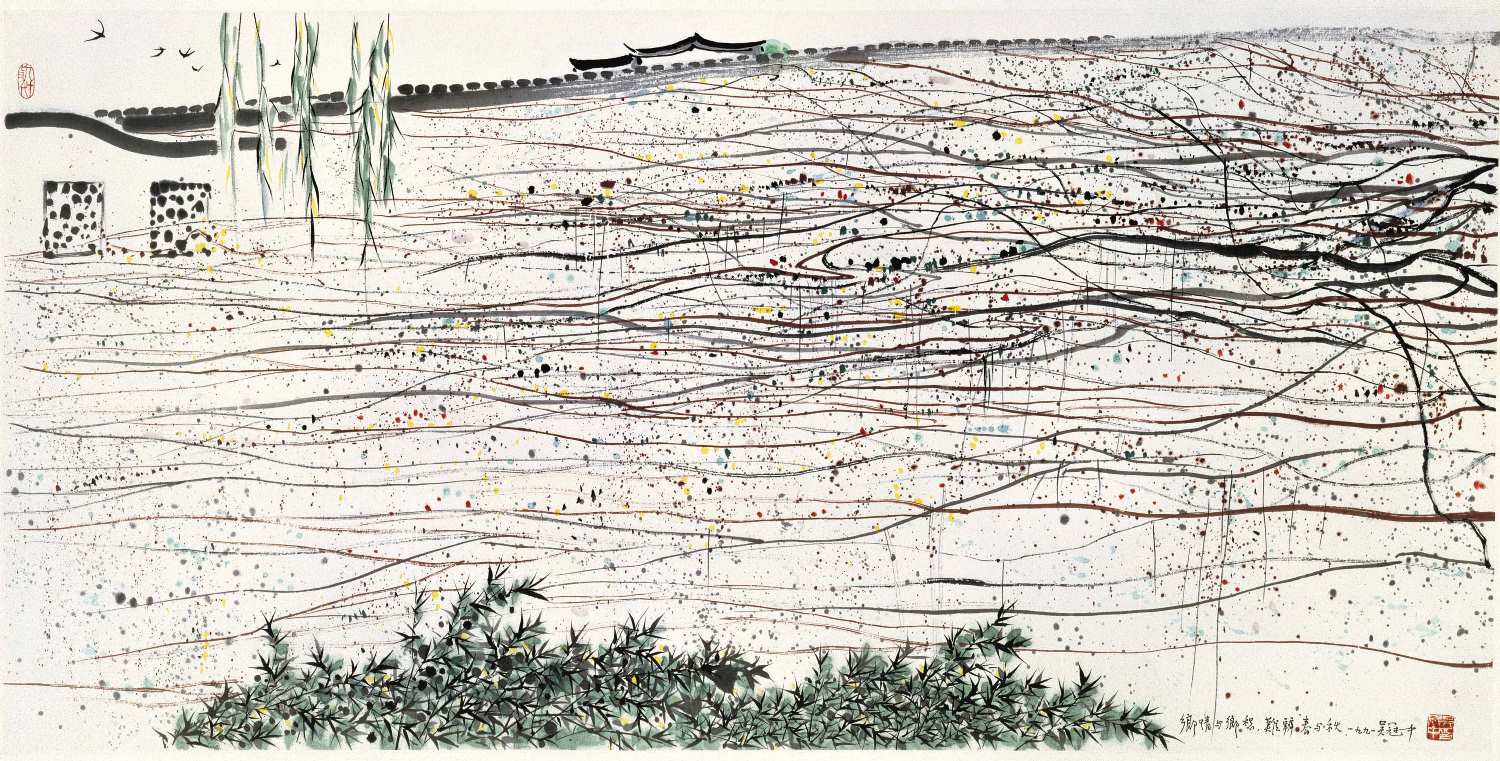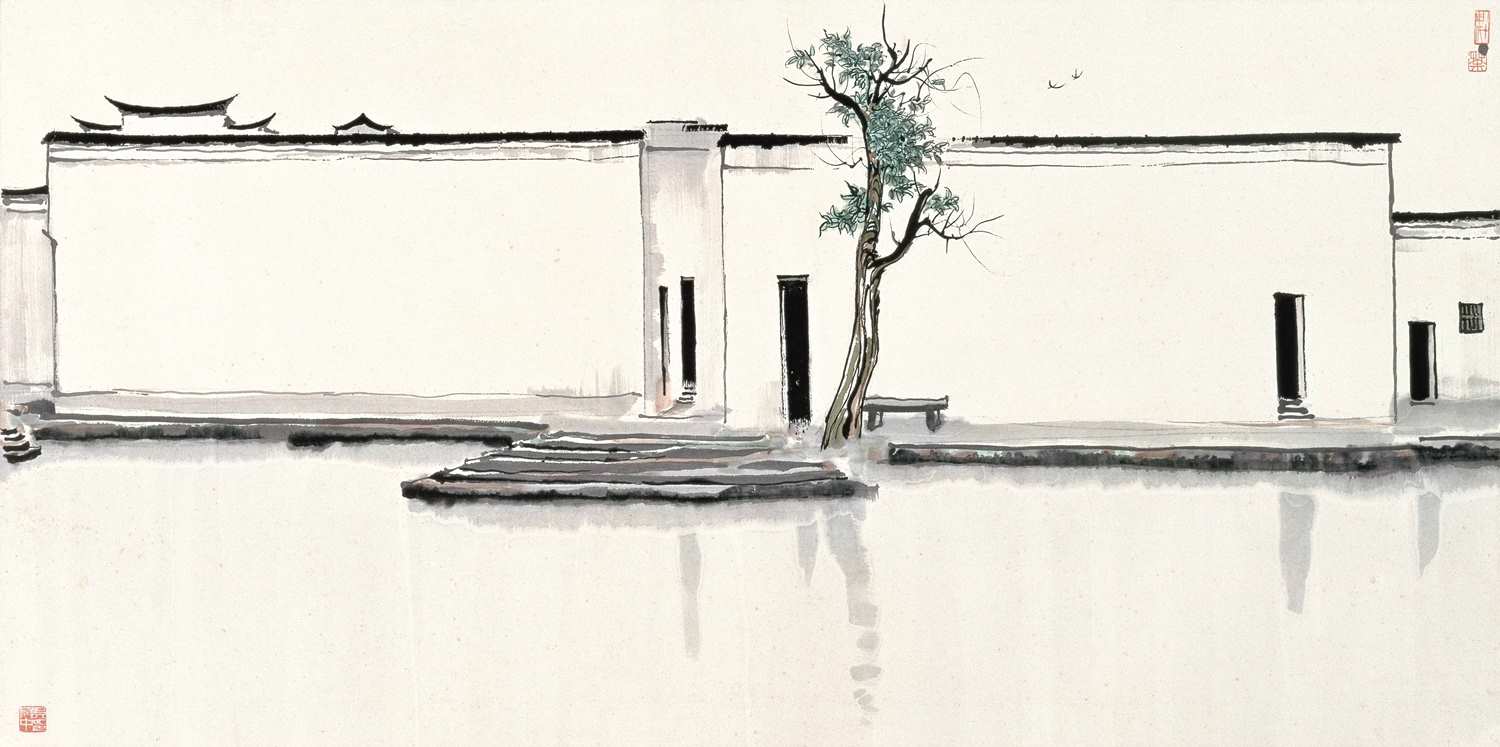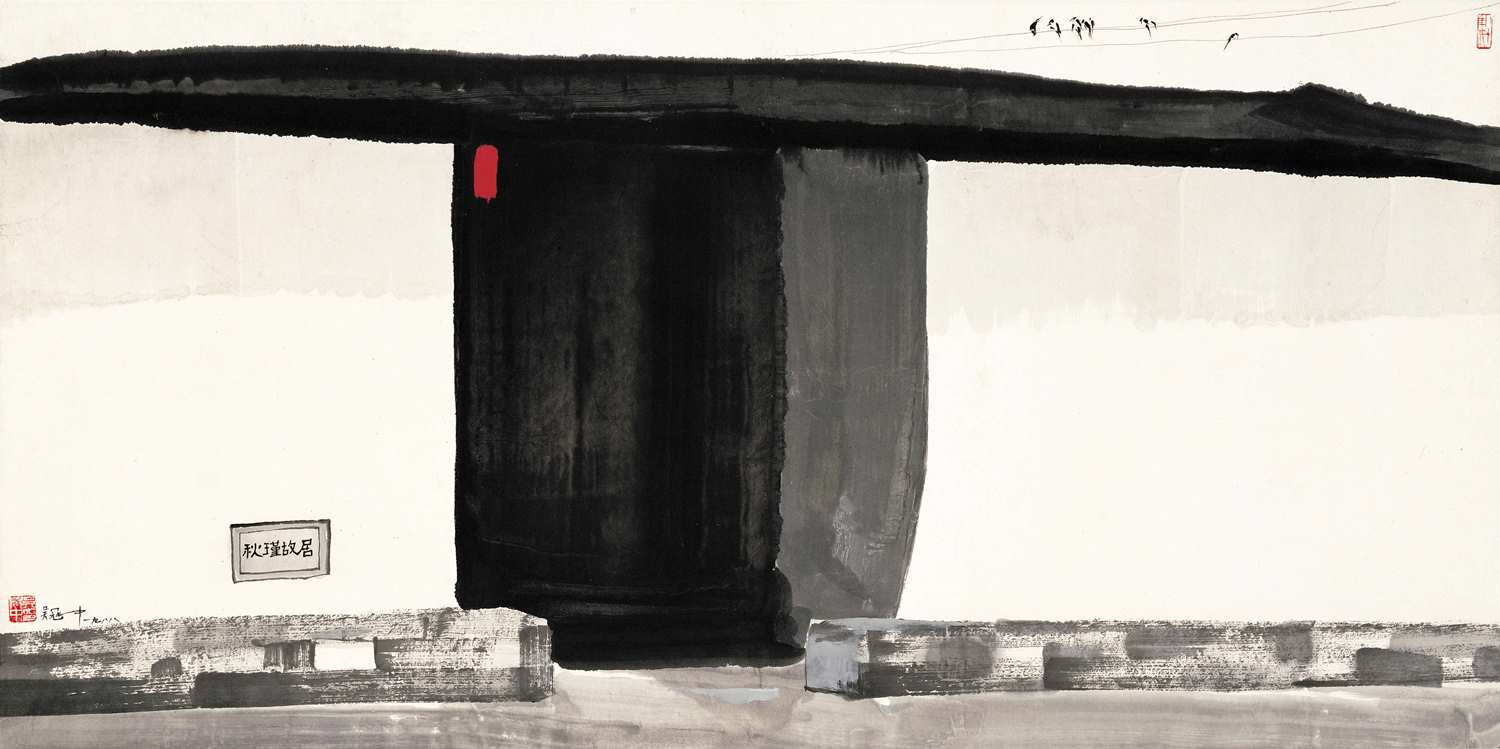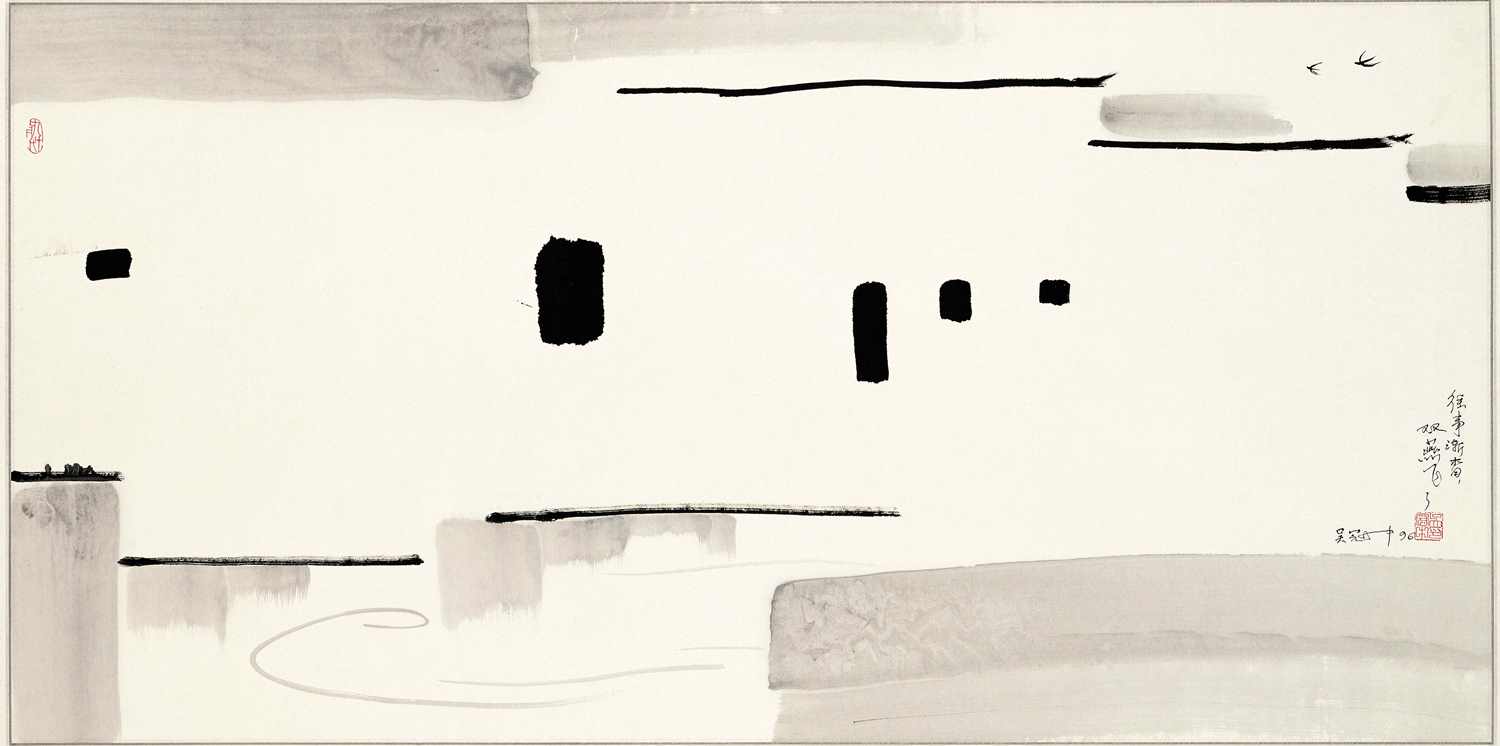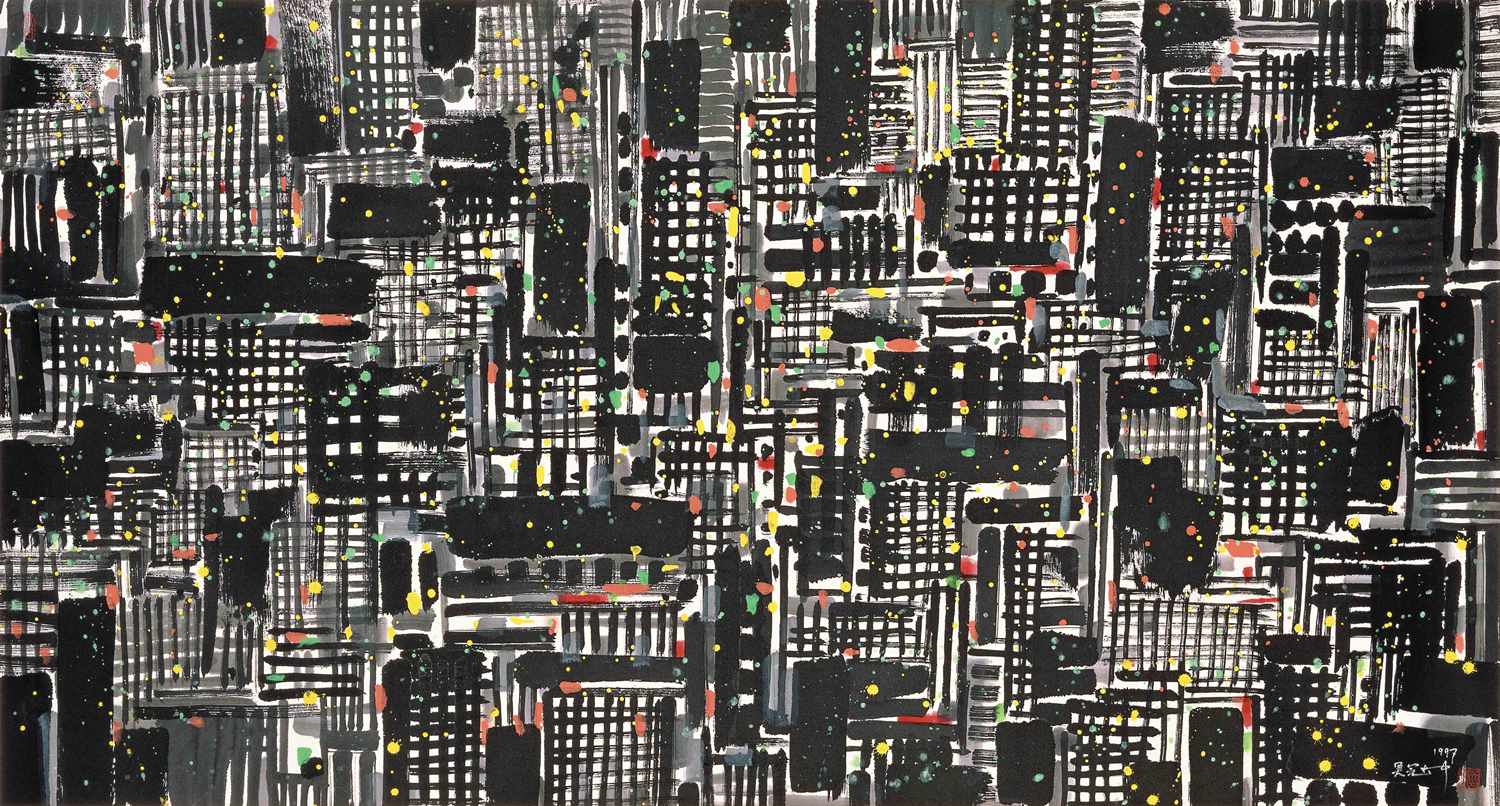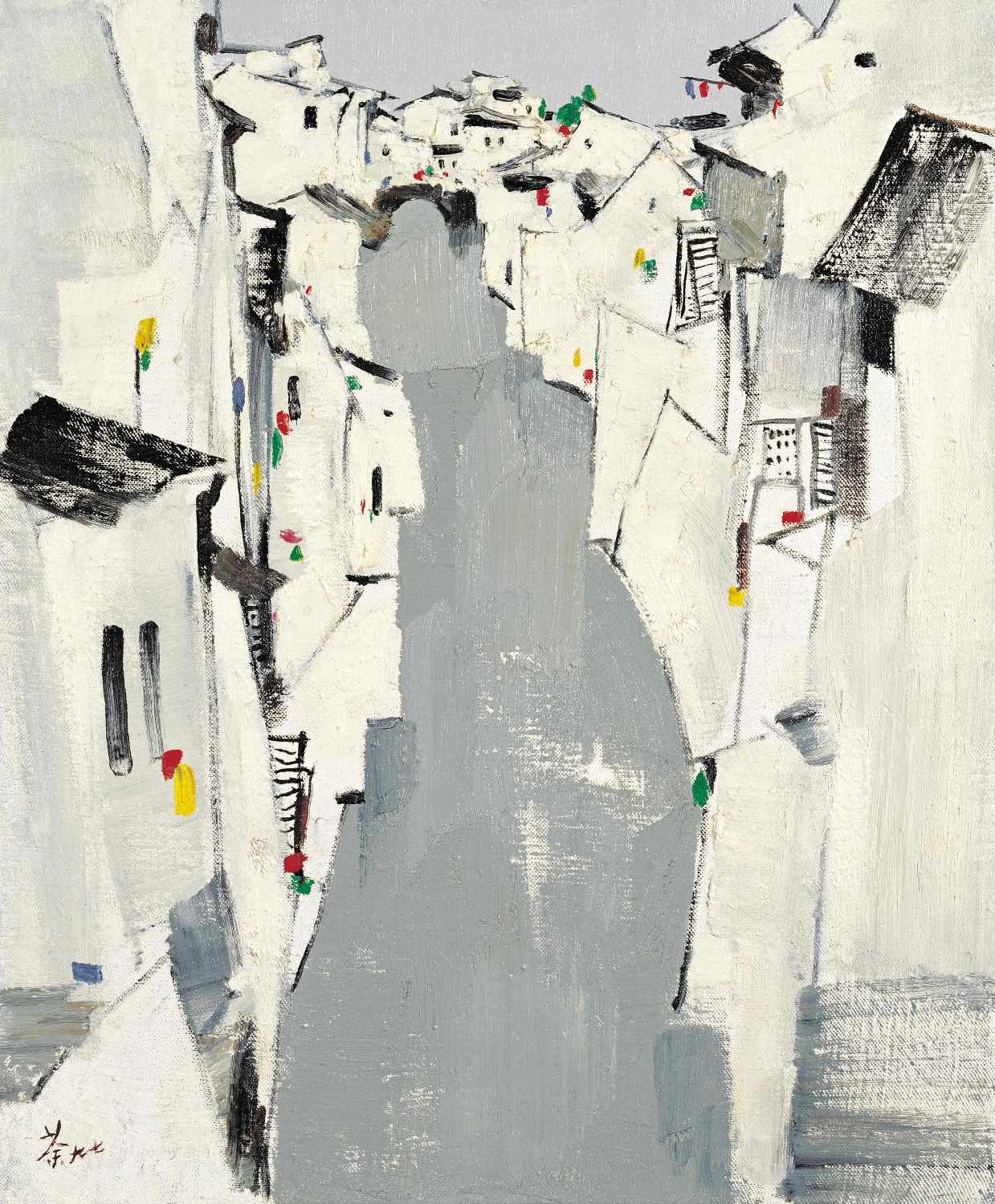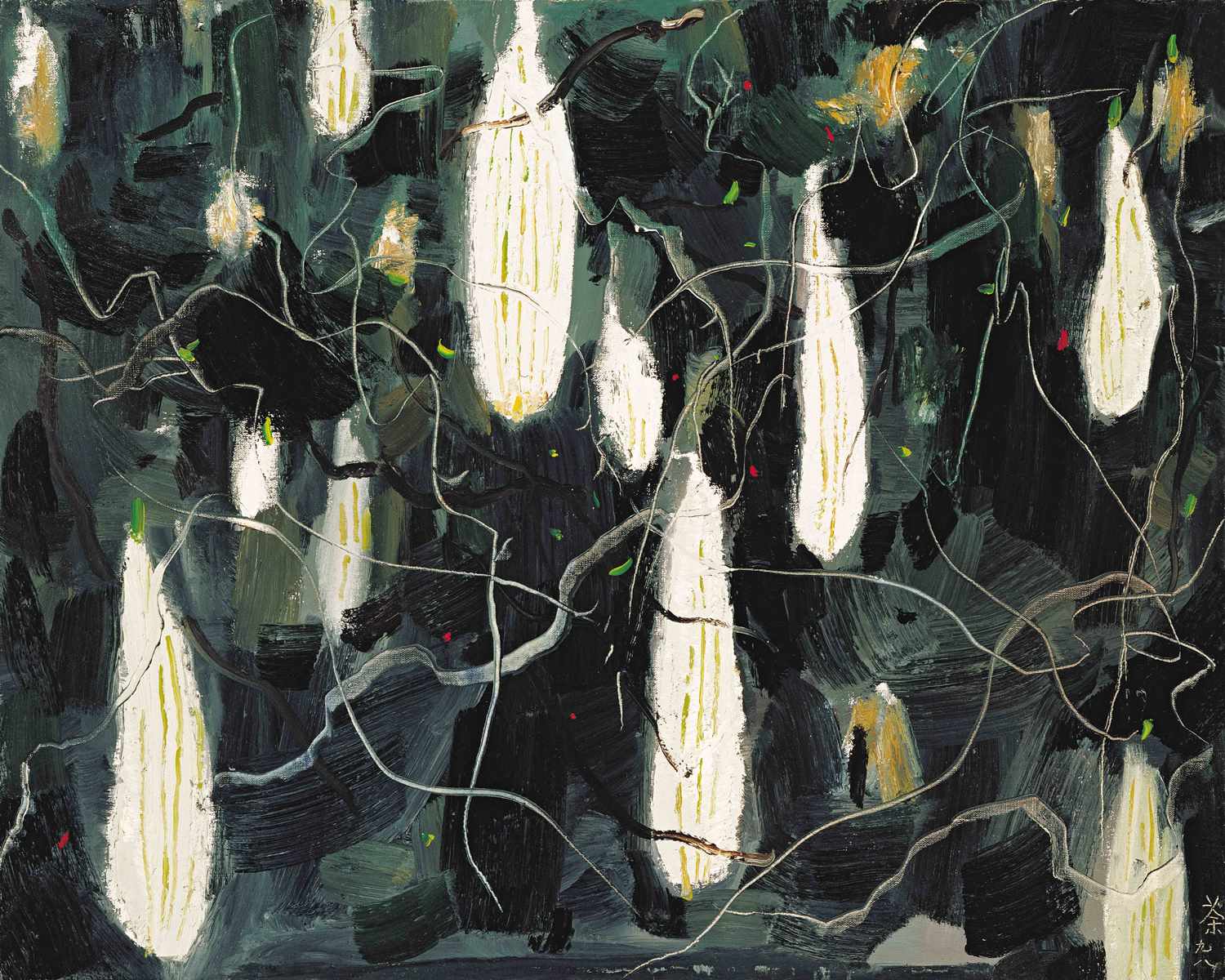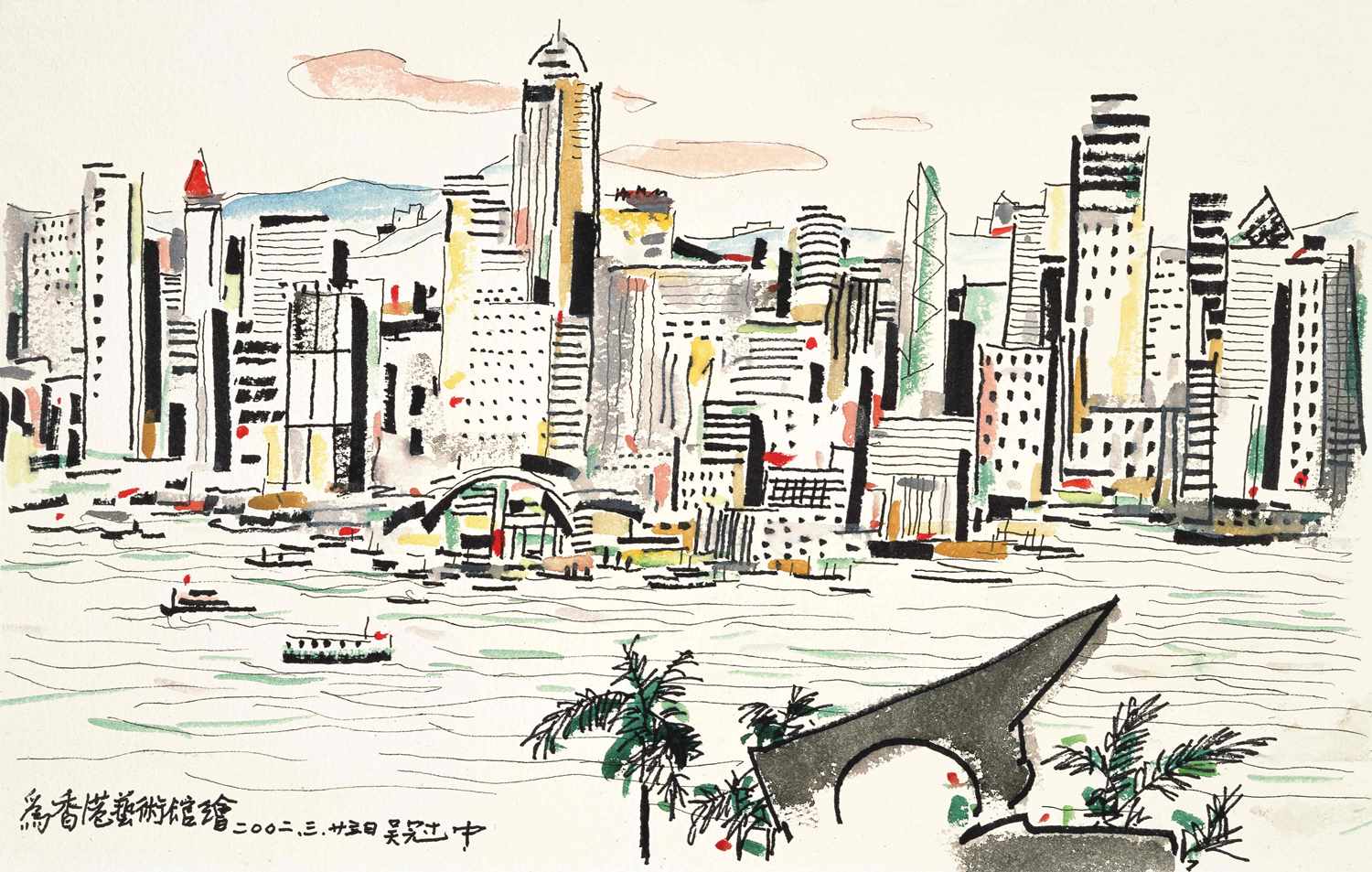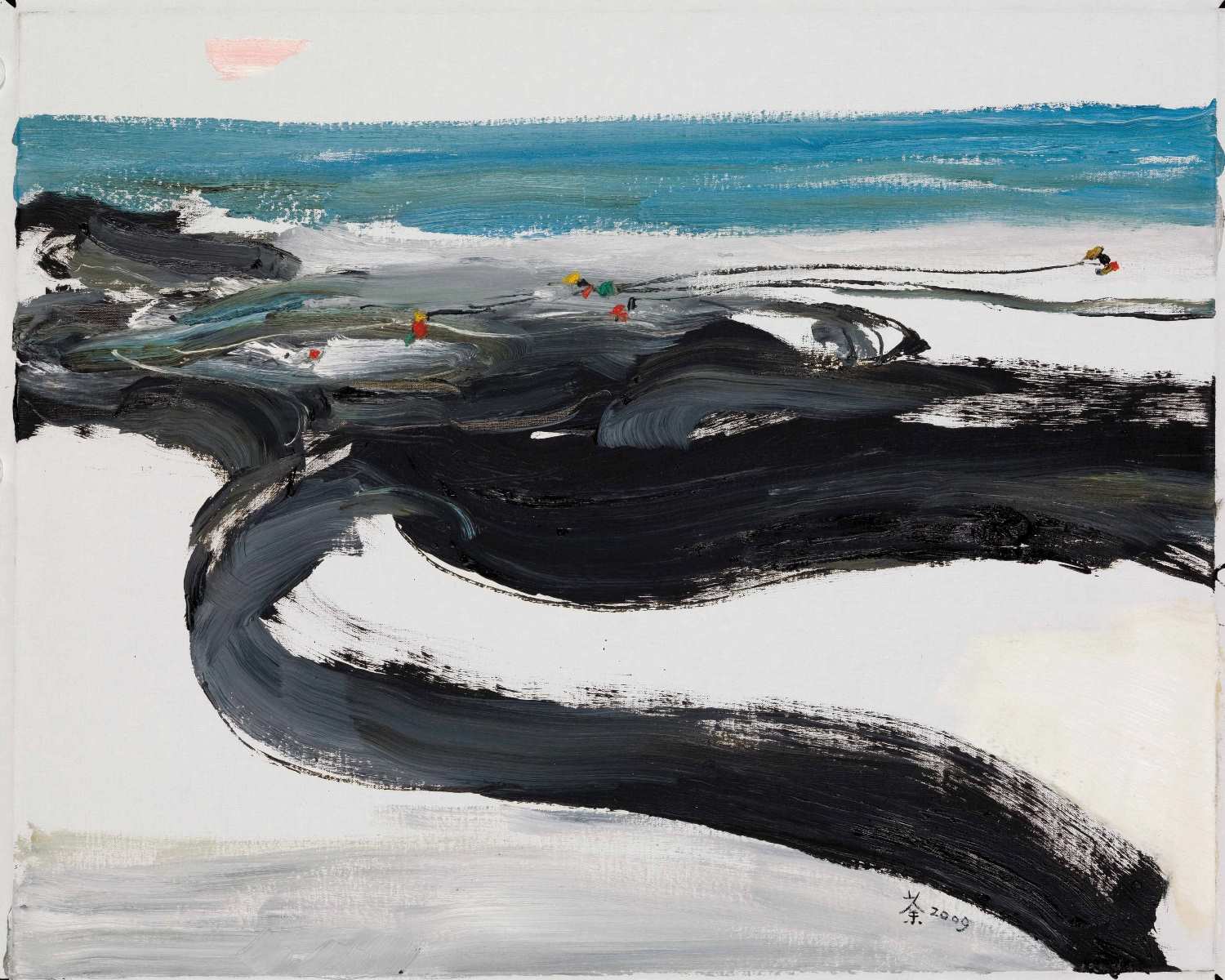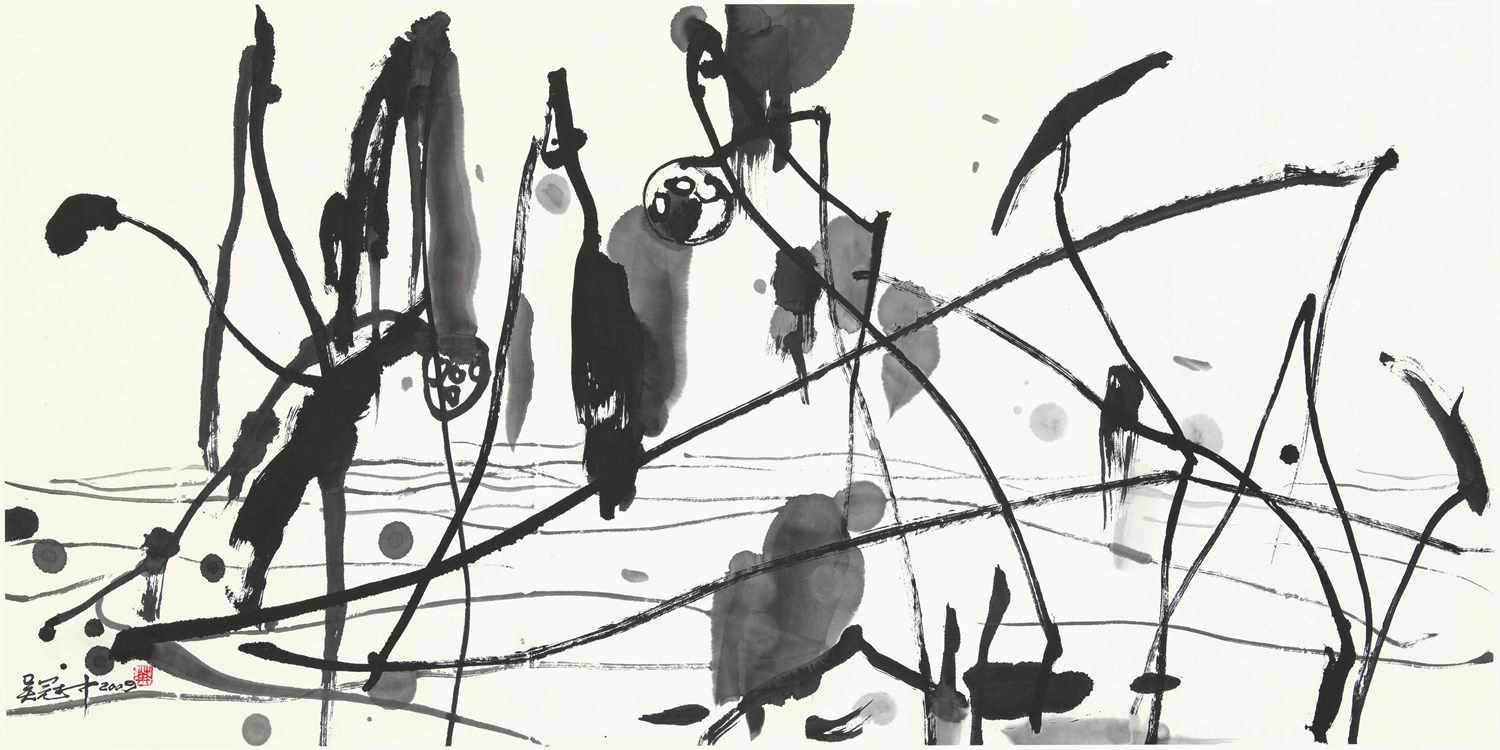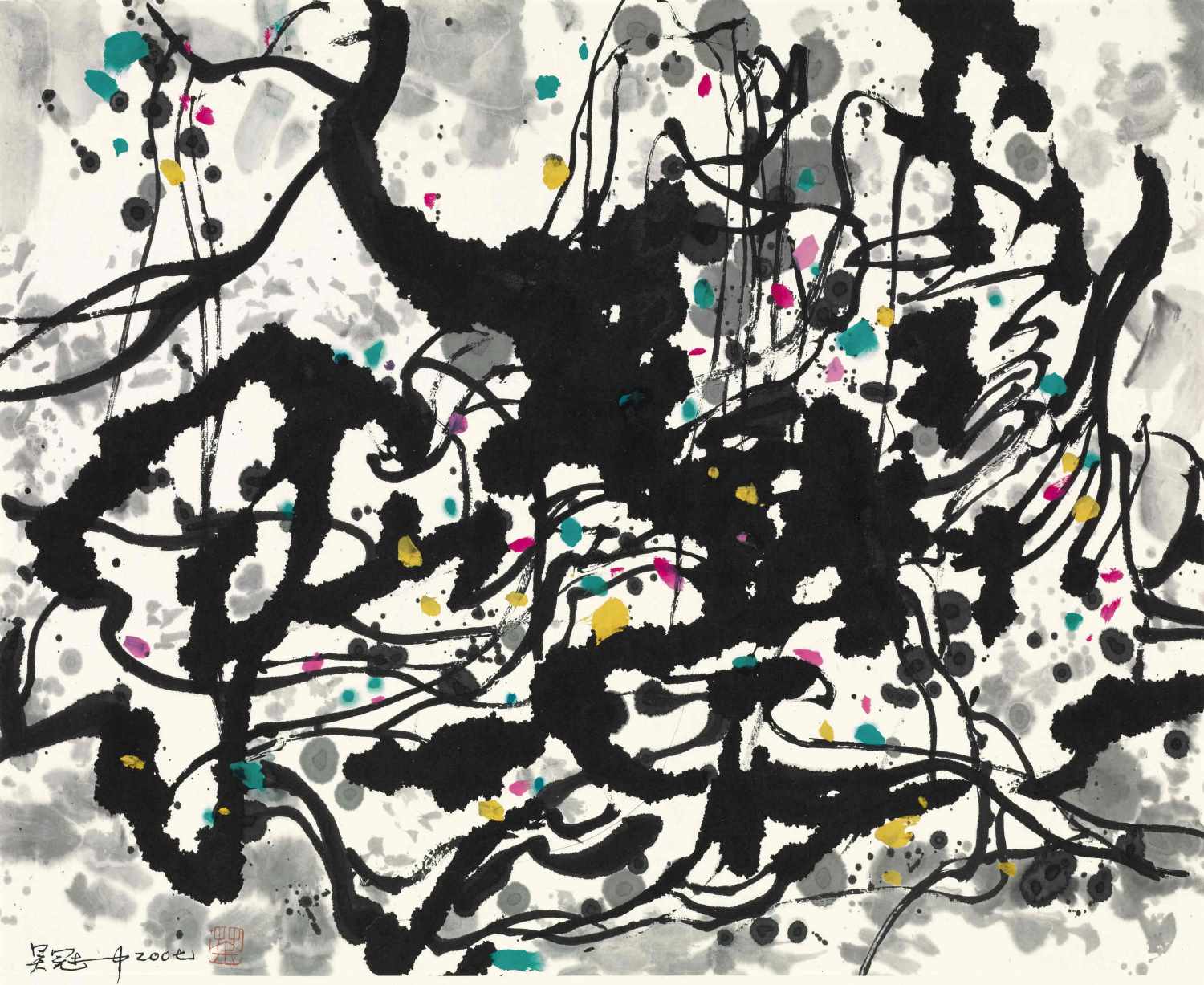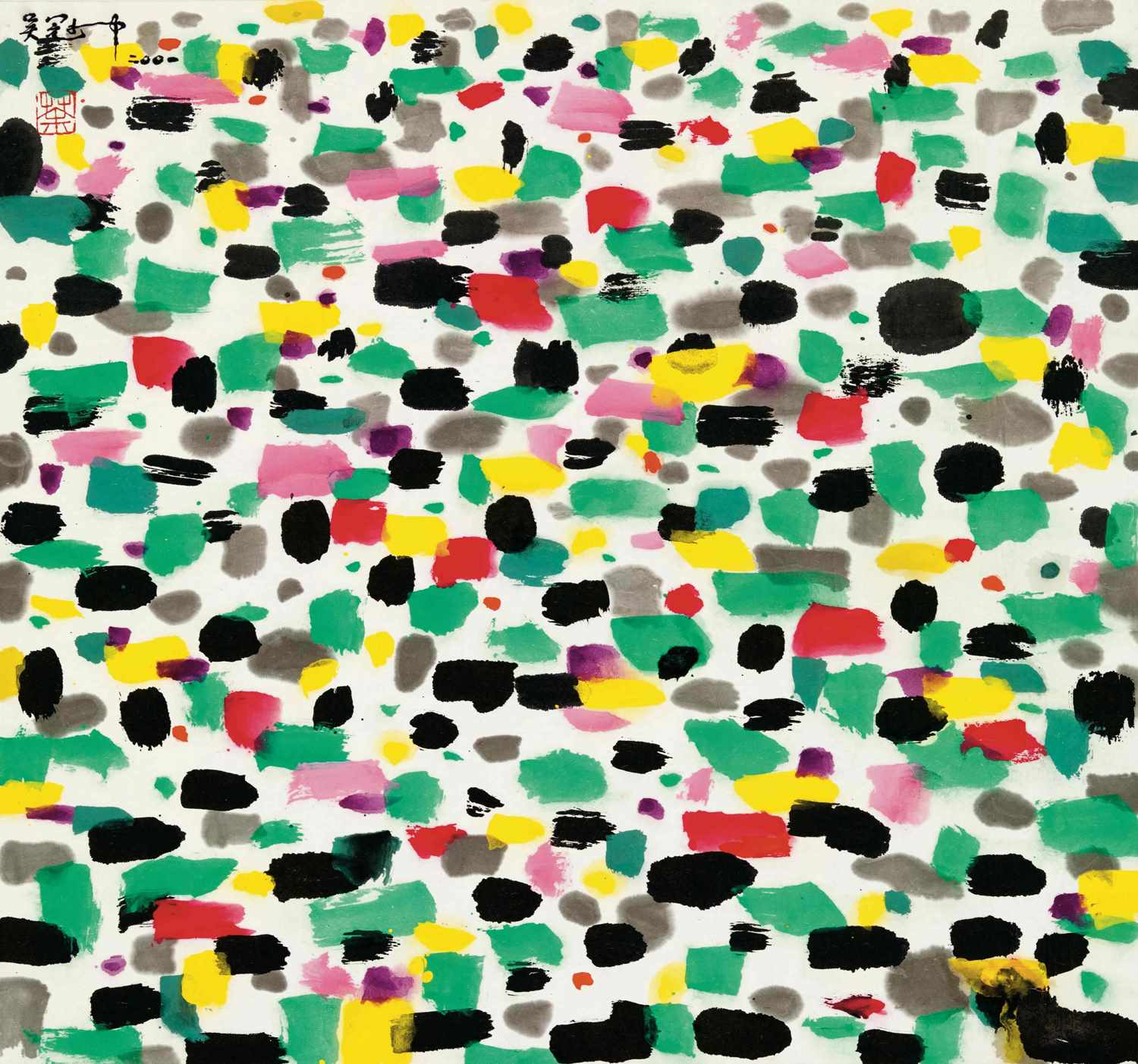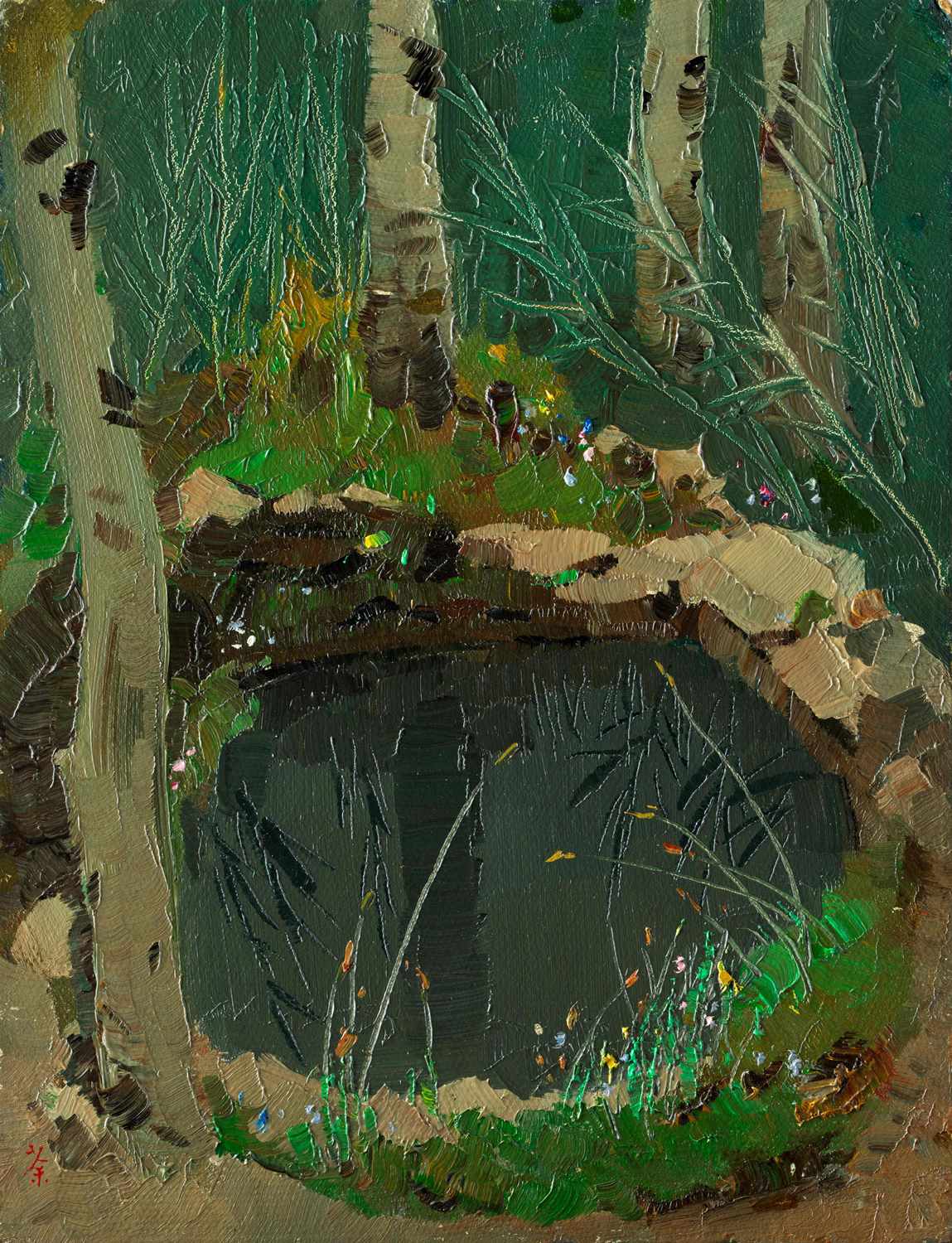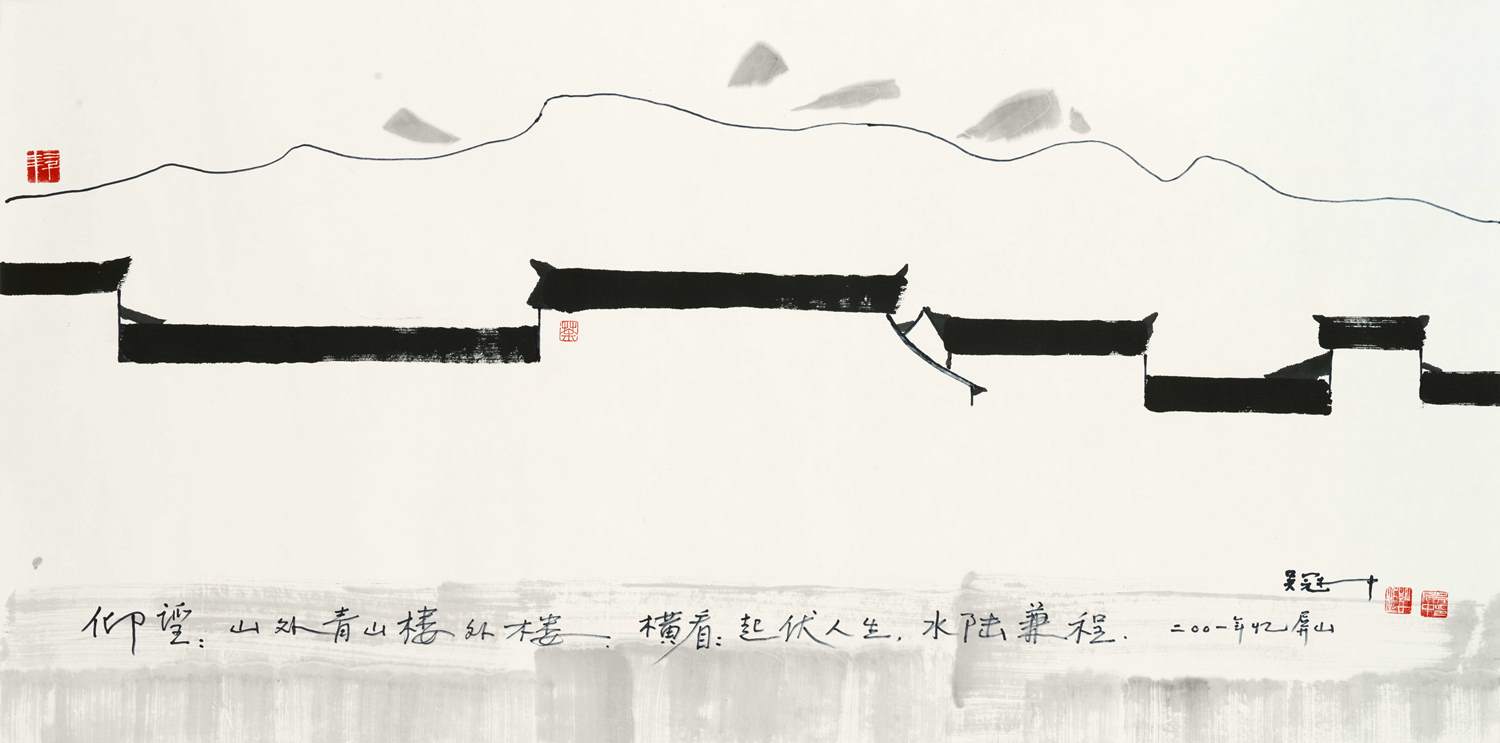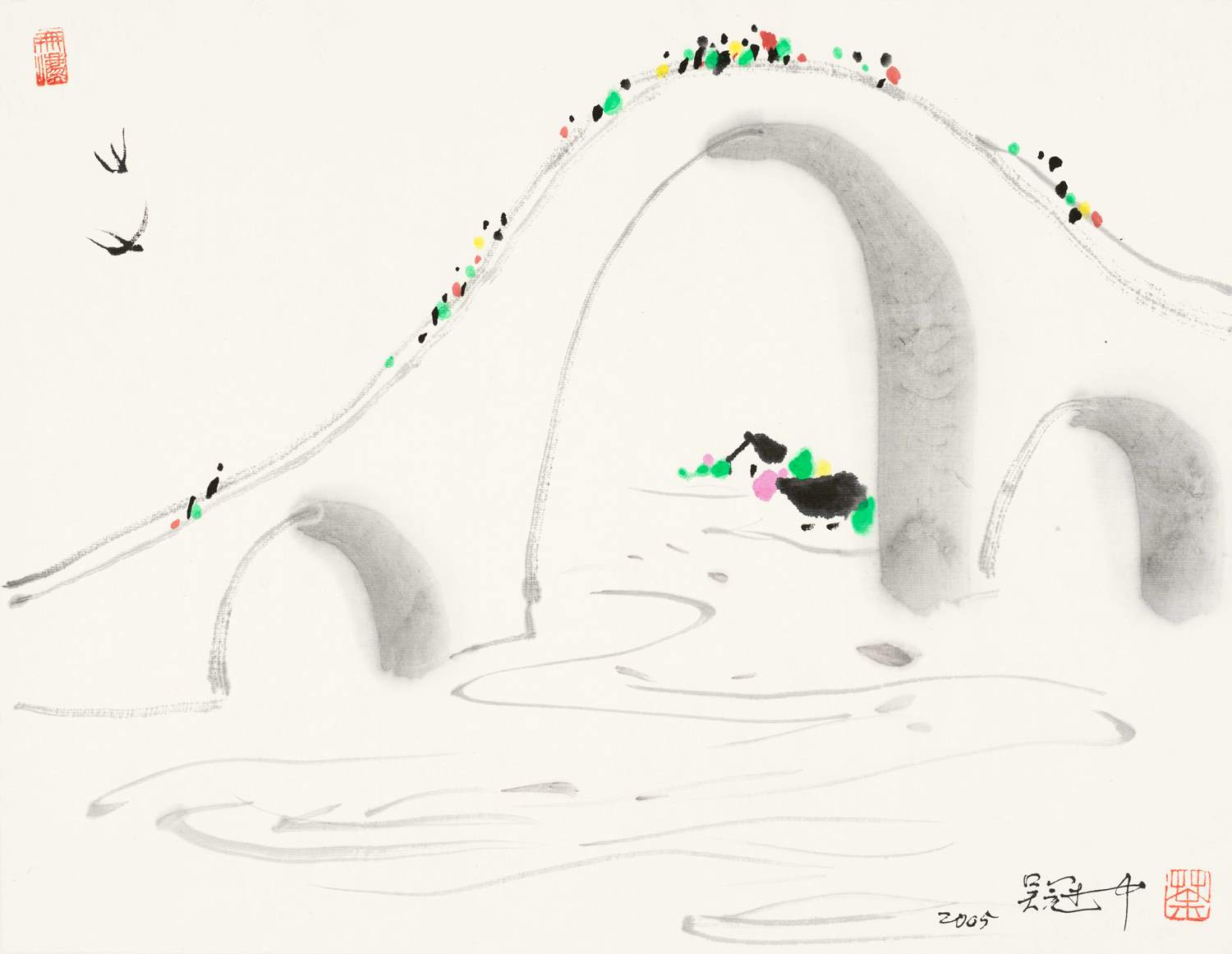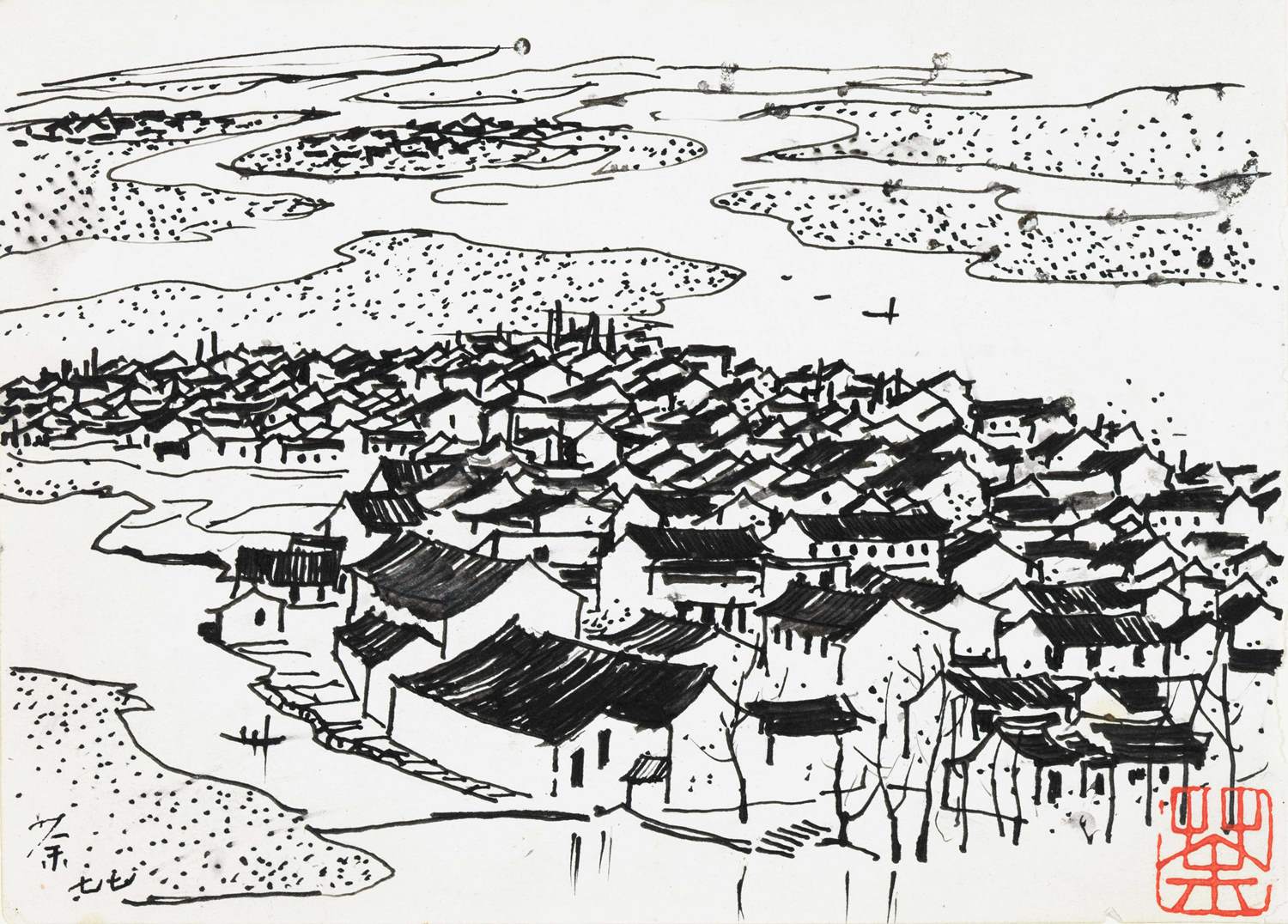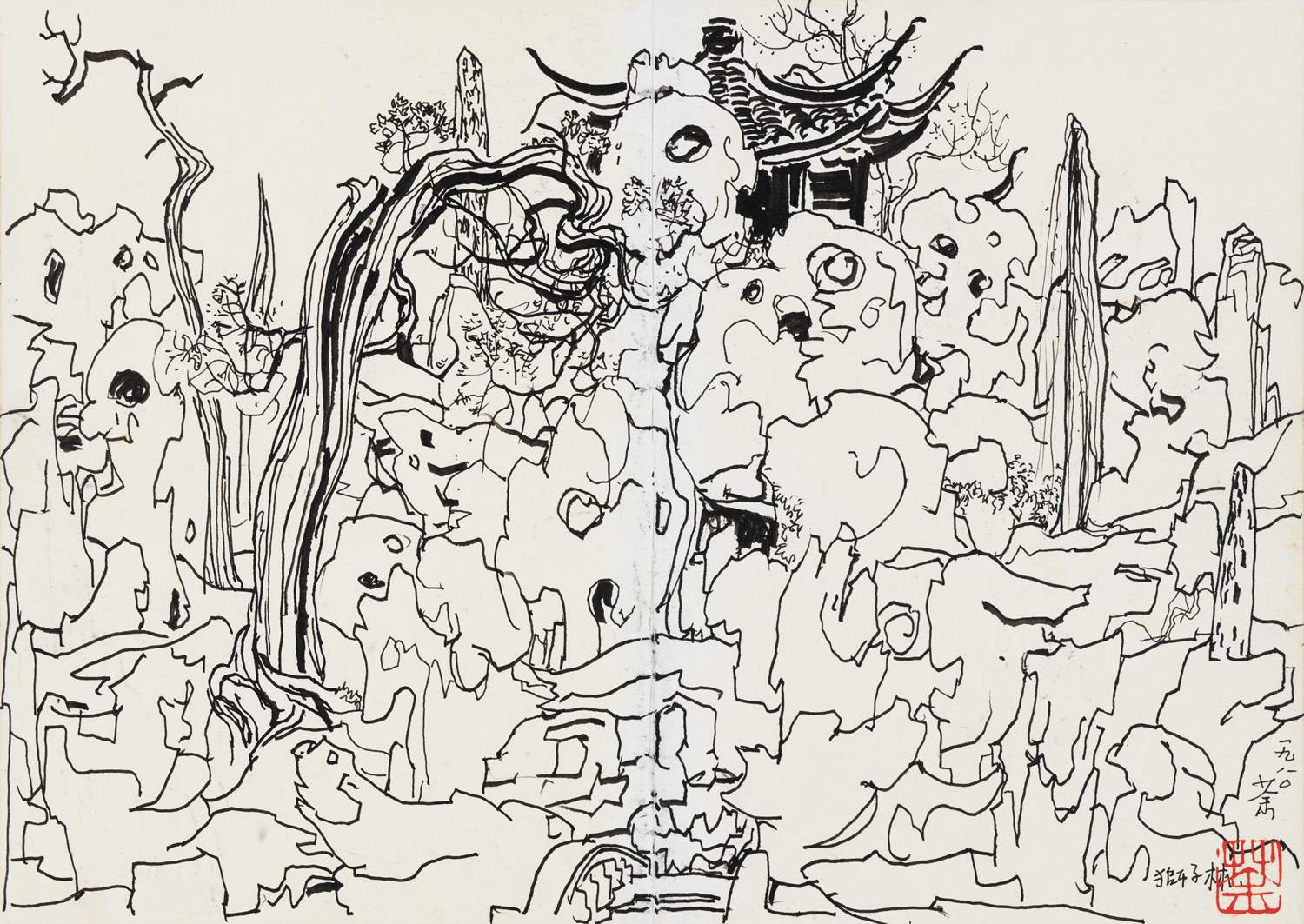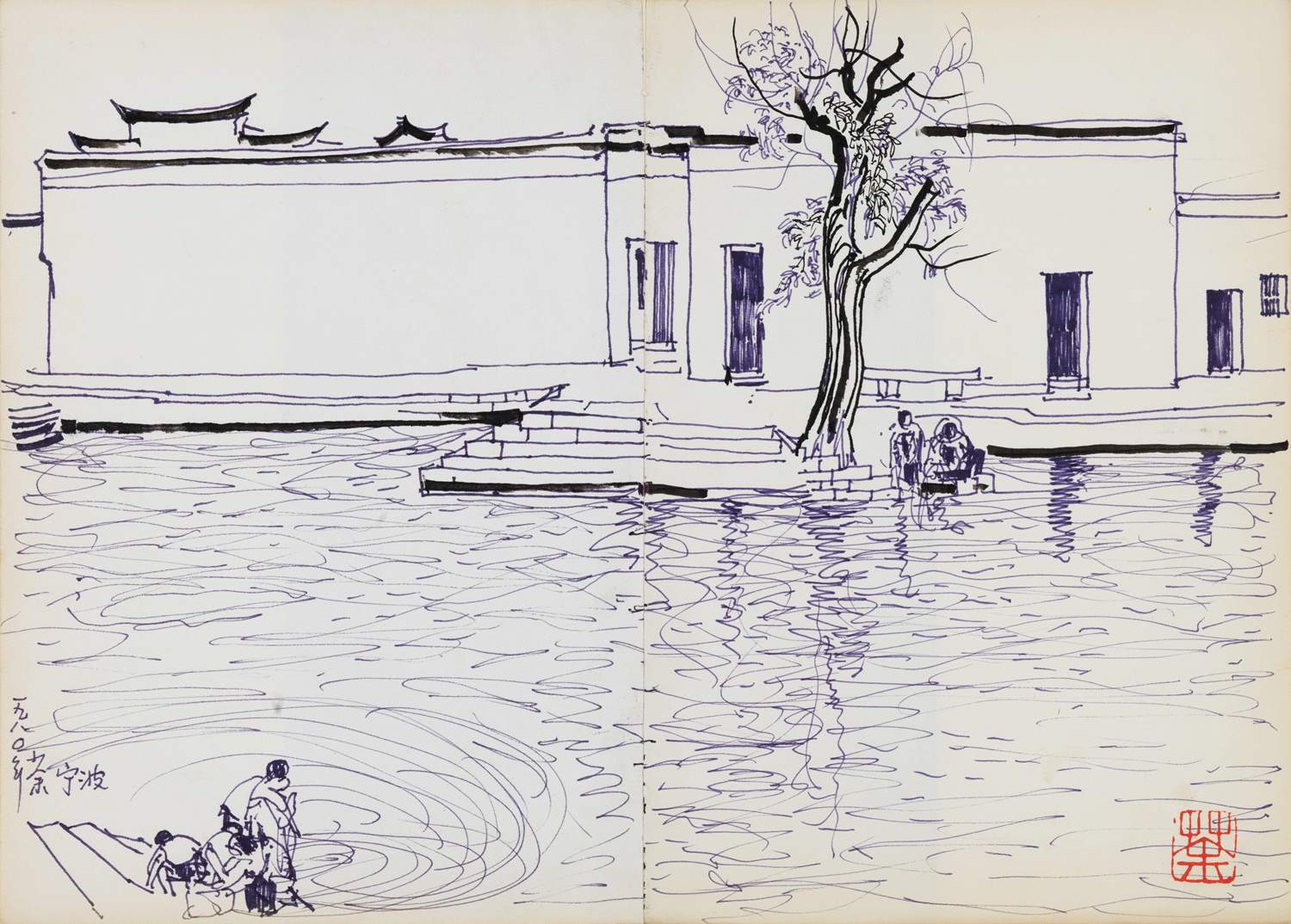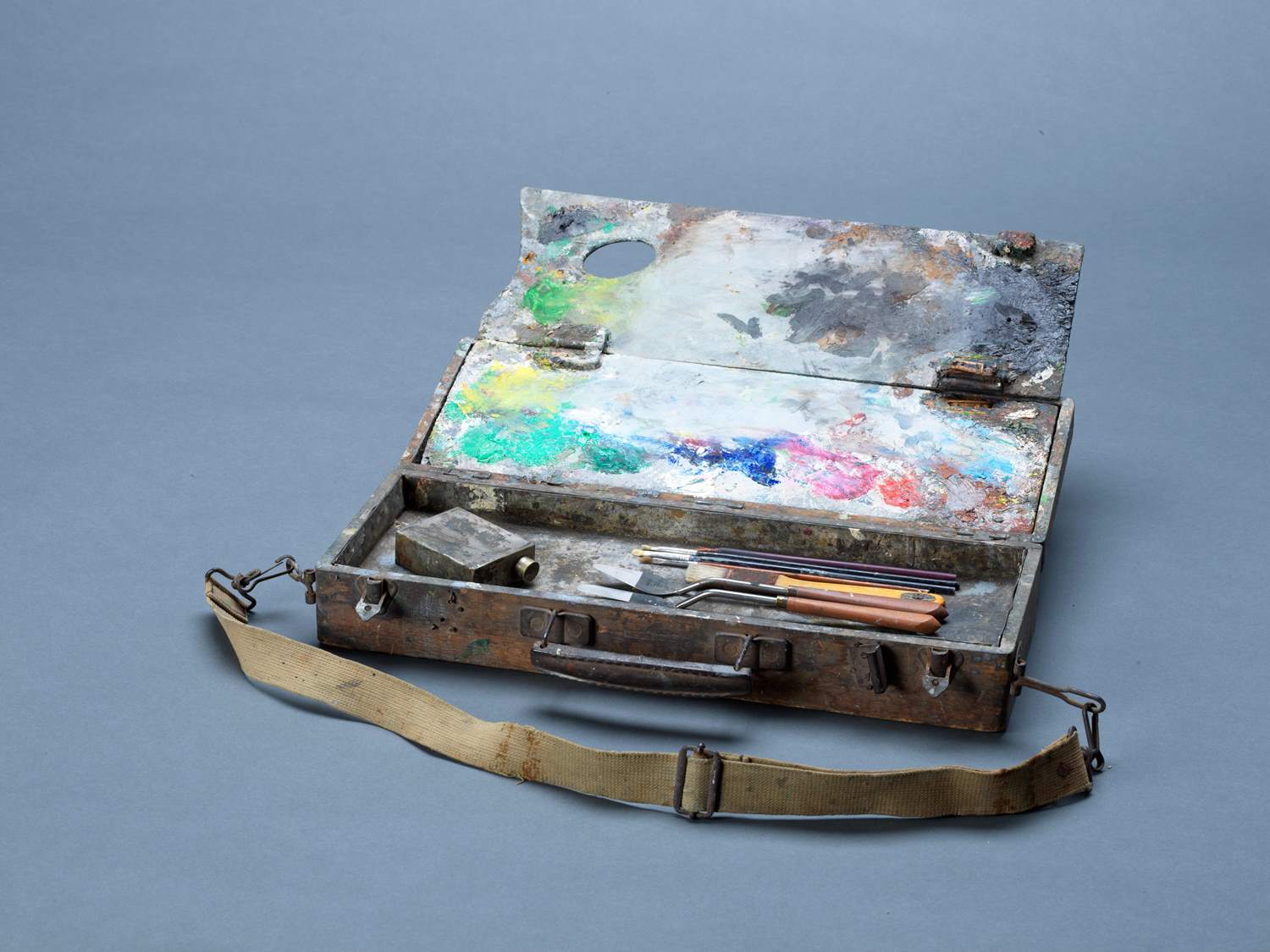 Web Content Display
Web Content Display
The Paintings and Personal Archives of Wu Guanzhong
Wu Guanzhong (1919-2010) was a master painter of the twentieth century in the Chinese and international art circles. Born in Yixing, Jiangsu province, he was admitted to the National Arts Academy of Hangzhou as a young man where he learnt from Lin Fengmian and Pan Tianshou. In 1947, he was the recipient of a national scholarship that put him on the road of further studies in France. His travel companion to France was the sculptor Xiong Bingming. In 1950, Wu Guanzhong decided to return to China through Hong Kong. Since then, he taught at the Central Academy of Fine Arts, Tsinghua University, Beijing Academy of Fine Arts and Central Academy of Fine Arts and Crafts respectively. During the Cultural Revolution, Wu was sent to the farmland of Hebei province for hard labour, yet he persisted in painting throughout the days of hardship. He first started painting with oil and then moved on to ink, searching for a way to fuse Eastern and Western art. His works bring together the aesthetics of traditional Chinese ink and modern Western art, pioneering the unique "Wu studio style" and endowing us with a wealth of great classics.
Wu Guanzhong had an enduring connection with Hong Kong. He visited Hong Kong on many occasions, such as hosting art exhibitions and attending academic seminars and talks by invitation. He made acquaintance with many members of the art circles. He also did sketching on the streets in Hong Kong, and the city is the subject of many of his paintings. In 2002, Wu Guanzhong gave an unprecedented demonstration of landscape sketching at the Hong Kong Museum of Art. Unperturbed by bad weather, he captured the Victoria Harbour on paper in the rain. The occasion became a favourite tale of the local art circle. Wu highly rated Hong Kong's cultural environment, asserting that Hong Kong was a place of fair and equitable systems where people made practical efforts and valued truth. To him, Hong Kong was a confluence where he could "see both the East and the West at the same time". It is a quality that can also be found in his art creations.
Wu Guanzhong made it clear that he would leave his best works to the nation and the people. He made several donations of artworks to public museums both in China and overseas during his lifetime. Over the years, he and his family made many donations to the Hong Kong Museum of Art, making up a huge collection of over 450 items. Together with two other paintings acquired earlier and donation from private collector, the Museum now boasts the largest and most diverse collection of works of Wu Guanzhong, as well as one of the key international centres for modern Chinese painting collection and research in the world.
This priceless collection includes Wu's oil paintings and ink paintings that showed his artistic development from figurative to abstract, works completed in the 1970s during his rural "dung basket" days, original sketches and manuscripts, painter's box and painting tools, documents he used and a certificate received in France as well as a ribboned gilt medallion awarded by the French Government. Showcasing the important journey of Wu's artistic creation in more than half a century, these objects command tremendous historical and artistic value. They stand witness to the precious friendship and affinity between Wu Guanzhong and the Hong Kong Museum of Art.
-
Memories of home
-
1991
-
Ink and colour on paper
-
83.5 x 164.5 cm
This is one of the two paintings by Wu Guanzhong that the Museum acquired. The swallows, pale walls, black tiles and vines frequently appear in Wu's paintings depicting his homeland - the Jiangnan region. They are the important motifs that mark the development of his Jiangnan series.
He once wrote that, "Fascinated by their entwinement and entanglement, I have painted many vines. However realistic and elaborate I have painted the vines in their full vitality, I have a feeling that I have failed to do them justice. My thoughts and emotions remain entangled even though the paintings are infused with my feelings." The artist's obsession with the theme is perhaps rooted in his love and longings for his native land. -
-
Two swallows
-
1981
-
Ink and colour on paper
-
69 x 138 cm
-
Donated by Mr Wu Guanzhong and his family
Black, white and grey are the main colours of the Jiangnan spring days. They are also bedrocks of the silvery-grey palette in Wu Guanzhong's paintings. These hues set foot on the path of his artistic journey. He said, "I have been drawing Jiangnan on and off all my life. Among my Jiangnan paintings, or even all my works, Two swallows is the most iconic and representative."
This painting combines Chinese ink techniques with geometric concept of the West. It inspired Wu to explore how best to blend the East and the West in art in the 1980s. Since then, he continued to experiment with almost pure abstract geometric shapes to express Eastern emotions, resulting in many captivating masterpieces.
In 2002, the Hong Kong Museum of Art showcased Two swallows alongside his later works Former residence of Qiu Jin and Reminiscence of Jiangnan in a major exhibition ― "Wu Guanzhong: A Retrospective". These works demonstrated his transition from figurative to almost pure abstract art. Wu Guanzhong visited the museum and liked this presentation very much. He described that "The private secrets in my heart are exposed to the public. A selection and combination of works from different periods reveal the purpose behind their creator's industrious efforts over several decades… The greatest joy to an artist is none other than being understood."
For this reason, Wu Guanzhong entrusted his three daughters to the Hong Kong Museum of Art. -
-
Former residence of Qiu Jin
-
1988
-
Ink and colour on paper
-
68 x 137.4 cm
-
Donated by Mr Wu Guanzhong and his family
Black, white and grey are the main colours of the Jiangnan spring days. They are also bedrocks of the silvery-grey palette in Wu Guanzhong's paintings. These hues set foot on the path of his artistic journey. He said, "I have been drawing Jiangnan on and off all my life. Among my Jiangnan paintings, or even all my works, Two swallows is the most iconic and representative."
This painting combines Chinese ink techniques with geometric concept of the West. It inspired Wu to explore how best to blend the East and the West in art in the 1980s. Since then, he continued to experiment with almost pure abstract geometric shapes to express Eastern emotions, resulting in many captivating masterpieces.
In 2002, the Hong Kong Museum of Art showcased Two swallows alongside his later works Former residence of Qiu Jin and Reminiscence of Jiangnan in a major exhibition ― "Wu Guanzhong: A Retrospective". These works demonstrated his transition from figurative to almost pure abstract art. Wu Guanzhong visited the museum and liked this presentation very much. He described that "The private secrets in my heart are exposed to the public. A selection and combination of works from different periods reveal the purpose behind their creator's industrious efforts over several decades… The greatest joy to an artist is none other than being understood."
For this reason, Wu Guanzhong entrusted his three daughters to the Hong Kong Museum of Art. -
-
Reminiscences of Jiangnan
-
1996
-
Ink on paper
-
69.5 x 138.5 cm
-
Donated by Mr Wu Guanzhong and his family
Black, white and grey are the main colours of the Jiangnan spring days. They are also bedrocks of the silvery-grey palette in Wu Guanzhong's paintings. These hues set foot on the path of his artistic journey. He said, "I have been drawing Jiangnan on and off all my life. Among my Jiangnan paintings, or even all my works, Two swallows is the most iconic and representative."
This painting combines Chinese ink techniques with geometric concept of the West. It inspired Wu to explore how best to blend the East and the West in art in the 1980s. Since then, he continued to experiment with almost pure abstract geometric shapes to express Eastern emotions, resulting in many captivating masterpieces.
In 2002, the Hong Kong Museum of Art showcased Two swallows alongside his later works Former residence of Qiu Jin and Reminiscences of Jiangnan in a major exhibition ― "Wu Guanzhong: A Retrospective". These works demonstrated his transition from figurative to almost pure abstract art. Wu Guanzhong visited the museum and liked this presentation very much. He described that "The private secrets in my heart are exposed to the public. A selection and combination of works from different periods reveal the purpose behind their creator's industrious efforts over several decades… The greatest joy to an artist is none other than being understood."
For this reason, Wu Guanzhong entrusted his three daughters to the Hong Kong Museum of Art. -
-
City night
-
1997
-
Ink and colour on paper
-
96.3 x 179.8 cm
-
Donated by Mr Wu Guanzhong and his family
Besides bridges and waterways in water towns, Wu Guanzhong also enjoyed painting bustling modern cities. To portray the brightness of city nightscape with ink, he explored various routes, yet remained unsatisfied with its subdued effect.
After numerous attempts, he created City night at the age of 78. He also wrote an article to share his exploration and what he had learned, "I started by focusing on the interlace of bold horizontal and vertical brushstrokes, and the illusion created by staggering buildings. They stand tall and compete with each other to reach for the sky as far as the eye can see. What the picture shows is a whole architectural complex but not any specific buildings. Neither is the city supposed to be Hong Kong, Tokyo, New York, Beijing, Shanghai or Shenzhen. The big and small dripping dots can be windows and doors, or otherwise. All of them complement the building silhouettes and chime in with the line and surfaces. The intense red, yellow and green dots and planes dance over the blacks, whites and greys. They are the eyes of the night, the burst of colourful merriments, and the most dominant notes in the painting."
One can say this painting embodies the artist's concept of modern Chinese painting, while reflecting his tireless search in art. -
-
Tashilhunpo Monastery
-
1961
-
Oil on board
-
44.6 x 119.6 cm
-
Donated by Mr Wu Guanzhong and his family
This is one of Wu Guanzhong's early oil paintings. Tibet was one of the places which influenced his creative approach.
In 1961, Wu Guanzhong joined the China Artists Association's five-month sketching tour in Tibet. It was a long and treacherous journey, and the alpine climate posed physical challenges. Yet, the painter was overjoyed as if he had won the lottery. While travelling by car, they passed by a particularly charming location that created a refreshing and unusual picturesque scene. He decided to take his painter's box there to do sketching at dawn the next day. However, even walking for more than four hours, he failed to find the scene he saw yesterday. He made comparisons repeatedly and came to realise that space was distorted by speed. When snow-capped mountains, plunging falls, towering trees and wild flowers in different orientations and locations were moved by speed, they conjured up extraordinary sights.
That experience motivated him to start doing collage in painting, adding innovation to compositions by radically adjusting the distance as well as displacing objects. He called this creative approach "move-the-site sketching". Tashilhunpo Monastery is one such example that features this technique. -
-
Waterway
-
1997
-
Oil on canvas
-
73 x 60 cm
-
Donated by Mr Wu Guanzhong and his family
Wu Guanzhong travelled across China to sketch the country's attractive faces, yet he had always been attached to Jiangnan where he was born and raised. Waterway is his idea of a typical Jiangnan settlement.
He was particularly fond of Jiangnan in early spring when it was shrouded in cool translucent grey. The palette forms a tranquil and harmonious picture with the white walls and black tiles. The red, yellow and green dots, as explained by Wu, adorn the tableau as if they are colourful gems set in the frame. They represent domestic activities in Jiangnan and the colourful laundry. As they account for an extremely small area of the overall silvery-grey setting, they are concentrated colour points and do not dazzle excessively even though they are brilliant tones. These colourful dots later became a signature characteristic of his paintings. -
-
Bitter melon homestead
-
1998
-
Oil on canvas
-
80 x 100 cm
-
Donated by Mr Wu Guanzhong and his family
Wu Guanzhong had been using the pen name "Tu" since he was young. Meaning "bitterness", it aptly predicts that the quest for artistic excellence is never easy.
Indeed, Wu's life was one of challenges and tortuous struggles. He once compared his life to a bitter melon. "No one has the freedom to choose his fate, just as the bitter melon plant has no choice but to bear bitter melon fruits. In my old age, I did a painting titled Bitter melon homestead. Bitterness always haunts me. It is deep in my heart."
Bitter melons are not bitter to him since he has fully tasted the bitterest of the bitterest. -
-
Victoria Harbour
-
2002
-
Marker and watercolour on paper
-
36 x 57 cm
-
Donated by Mr Wu Guanzhong and his family
During the exhibition "Wu Guanzhong: A Retrospective" in 2002, Wu Guanzhong gave his first ever live sketching demonstration at the Hong Kong Museum of Art. Sketching the Victoria Harbour in the rain, this occasion became a favourite tale of the local art circle.
From the artist's writings, we can know how he felt about that event. He recalled, "Responding to great public demand, the Museum of Art consulted me about the possibility of performing a public sketching demonstration. I do not like to paint in front of the public, nor have I ever done any demonstration because it is impossible to get into the mood when it is a show. However, they explained that painters today seldom do sketching and young artists do not know where to start. As I have been sketching all my life, they hope people would not miss this only opportunity and asked me to encourage the younger generation. Unable to refuse the host's kind intention and the public's enthusiasm, I agreed to provide a "service" of demonstrating sketching for once. Since it's a service, the outcome does not matter. They were prepared to record the whole sketching process, from my first stroke on paper to the last, which would be put into the archive. I picked Victoria Harbour as the subject, which I would sketch on the podium of the Museum… On the day of demonstration, the lobby was packed with people. Alas! There was heavy fog and visibility was down to fifty metres. All the skyscrapers around Victoria Harbour disappeared in the illusory space of mist and clouds. The fog did not clear up and the audience was getting impatient. I did not want to disappoint the crowd, so I portrayed the buildings and ferries in the harbour by memory. How I composed the buildings, my sequence of strokes as well as the control and balance of strokes might serve as a reference to some people. Yet sketching is not about copying, it's the vitality that is being sketched, a vitality that is open to interpretation." -
-
Mending nets
-
2009
-
Oil on canvas
-
80 x 100 cm
-
Donated by Mr Wu Guanzhong and his family
In 1982, Wu Guanzhong was amazed by the vista when he was up on a cliff taking a bird's eye view of the Shitang fishing village, Wenling county, Zhejiang province. The pulled-open fishing nets spread out in the water like a giant dragon, and colourful dots from the fishermen's clothes were distributed across them, just like musical notes scattered across the strings. He saw colours and rhythm. It was an exhilarating and gripping scene. Back at home, he attempted to capture his feelings at that moment with ink based on his sketch. He began by expressing the fishing nets' palpability with a dark green tone but failed to achieve the ideal effect. After several attempts, he decided to portray the fishing nets with one single brushstroke of black ink. Black was much more solid than the green and those coloured figural dots sparkled more conspicuously against nets in black. Accentuated by the figurative background of the anchorage, viewers could easily appreciate his abstract expression of mending nets. This piece of work exemplifies Wu's advocate that abstract painting must involve emotional exchange with the people ― his creative concept of "kite with an unbroken string".
Mending nets in ink was showcased in the first thematic exhibition of works by Wu Guanzhong presented by the Hong Kong Museum of Art in 1995 ― "Vision and Revision: Wu Guanzhong". In 2009, the artist reinterpreted this painting in oil. The abstract feeling was even stronger this time and the nets in black oil were much more solid than ink. Indeed, Wu Guanzhong had spent his whole life discovering the affinity and qualities of oil and Chinese ink, Eastern art and Western art. -
-
Leaving youth behind
-
2009
-
Ink on paper
-
69 x 138 cm
-
Donated by Mr Wu Guanzhong and his family
"When a tree is old, the roots are exposed. When a lotus is old, its stalks break. It is better to break than to submit, leaving no regrets even when youth is gone."
The withered lotus had special meaning to Wu Guanzhong. He lived near Beihai Park in Beijing where he often visited for walks after work or in his spare time. Life was unspeakably tough during the Cultural Revolution and he did not even dare to draw any paintings. He passed by Beihai Park one day and saw withered lotus stalks and leaves jutting high and low above the frozen water. Most of the leaves had fallen but many stalks, though broken, stood upright. Their intense black was eye-catching. It revealed the bitterness of life that was hidden deep in the bones. That solemn and stirring visual effect was translated into an urge to draw, yet the social and political pressure at that time forbade him to pick up his brush.
Many years later, he made up his mind to trace and recapture the creative conception from some three decades ago. He expressed the tragic feelings with oil and the lofty integrity with ink. This painting is the story of his life. -
-
A sketch of Chinese cypresses, the original draft
-
1974
-
Marker on paper
-
102 x 312 cm
-
Donated by Mr Wu Guanzhong and his family
In 1974, Wu Guanzhong saw the four colossal Chinese cypresses at the Situ Temple in Guangfu of Suzhou, which were named as "the clear, the strange, the ancient and the weird" by the Qing emperor Qianlong. These trees survived lightning strikes and sprouted new shoots from their burnt fragments. Their unique form and tenacious vitality touched him deeply. He stood in front of the trees and recorded them on paper.
Wu Guanzhong was perceptive when dealing with complex compositions like this, "Many painters, including myself, went round the trees looking for a perspective to sketch. It is difficult to settle for a spot, faced with such entangled branches. Eventually I put together a few sheets of Korean paper to make a long scroll and drew around the trees." After returning to Beijing, he did several other semi-abstract paintings that share a common motif of Chinese cypresses and feature intertwined dots and lines, such as Revival. As Wu described, this painting featured "the revival after deep sleep. The robust thick lines, flowing thin lines, and swirling colour patches and dots suggest the revival of vitality in early and late spring all at once." -
-
Revival
-
2007
-
Ink and colour on paper
-
48 x 59 cm
-
Donated by Mr Wu Guanzhong and his family
In 1974, Wu Guanzhong saw the four colossal Chinese cypresses at the Situ Temple in Guangfu of Suzhou, which were named as "the clear, the strange, the ancient and the weird" by the Qing emperor Qianlong. These trees survived lightning strikes and sprouted new shoots from their burnt fragments. Their unique form and tenacious vitality touched him deeply. He stood in front of the trees and recorded them on paper.
Wu Guanzhong was perceptive when dealing with complex compositions like this, "Many painters, including myself, went round the trees looking for a perspective to sketch. It is difficult to settle for a spot, faced with such entangled branches. Eventually I put together a few sheets of Korean paper to make a long scroll and drew around the trees." After returning to Beijing, he did several other semi-abstract paintings that share a common motif of Chinese cypresses and feature intertwined dots and lines, such as Revival. As Wu described, this painting featured "the revival after deep sleep. The robust thick lines, flowing thin lines, and swirling colour patches and dots suggest the revival of vitality in early and late spring all at once." -
-
Faces unchanged
-
2001
-
Ink and colour on paper
-
45 x 48.2 cm
-
Donated by Mr Wu Guanzhong and his family
Wu Guanzhong donated his four final works together with Faces unchanged of 2001 to the Hong Kong Museum of Art in 2010. This painting had been hanging up on the wall of the artist's living room since it was completed. Wu Guanzhong apparently had very special feelings towards this piece of work. He wrote in an article that, "Li Yu sadly missed the opulent palace that he lost: only the faces have changed. The flowing stream cannot make the fallen blossoms stay, and the blossoms cannot keep their freshness and vivid colours. I splash bright colours only to emphasis that the faces have not changed or will not change... wishfully."
In this painting, Wu had eliminated all the lines, leaving only colour dots and planes. Looking at this abstract composition, some may think that the string of his "kite with an unbroken string" was broken after all. He took another view nonetheless, "Even though the tangible lines are broken, I still have the remote control in my hands." This unbroken string is emotion. He was against pure abstract expression because his paintings often have hidden meanings, expressing the true words in his heart. No matter how the art form or creative approach change, the emotion stays the same ― faces unchanged. -
-
A well
-
1972
-
Oil on pasteboard
-
36.2 x 28.2 cm
-
Donated by Mr Wu Guanzhong and his family
After his return to China from Paris in 1950, Wu Guanzhong was caught in a series of political movements which had an enormous impact to his life and artistic creation. He was banned from painting during the Cultural Revolution. Subsequently, he was allowed to paint one day in a week. Resources were extremely poor then and he had to use a small blackboard as drawing board and a rural dung basket as easel. He was mocked and nicknamed the "dung basket painter". Yet this did not bother him at all because creating art was a pleasure in life, something that allowed him to forget the hardships he was going through. He painted many rural landscapes during that period. Given the lack of space, they were all small paintings. Wu Guanzhong did not give up on art even in such challenging circumstances. Instead, he continued to make breakthroughs. -
-
Chinatown
-
1993
-
Ink and colour on paper
-
68.5 x 68.2 cm
-
Donated by Mr Wu Guanzhong and his family
Wu Guanzhong loved to paint landscapes of the Jiangnan region, not only because he was born there, but more importantly because he first developed the aesthetic awareness when he was trained in Hangzhou.
He had done a great number of paintings featuring Jiangnan houses. Among those, old houses with black tiles and white walls appear most frequently. The beautiful combinations of black and white planes produce contrasts and interlocks, giving rise to myriads of changing scenes. Fascinated by this, he gradually reduced the figurative details of the houses to transform them into beautiful geometric structures.
Wu Guanzhong strove to develop a set of unique visual elements and guided viewers to appreciate the beauty of the abstract world through his Jiangnan paintings. -
-
Perspectives
-
2001
-
Ink on paper
-
68.7 x 139 cm
-
Donated by Mr Wu Guanzhong and his family
Wu Guanzhong explored his artistic path by moving back and forth between ink and oil all his life. He once compared ink painting to a river, and oil painting to a road that runs parallel. He started off at the small path and moved on to the river for a while. When he felt he could not go any further with oil painting, he switched to ink. When ink had exhausted itself, he returned to oil. In his golden years, he advanced by taking both routes alternatively. He was one of the few artists in China and indeed the world that master both Chinese ink and oil painting.
In this painting, he portrayed his favourite white walls and black tiles with simple lines. He then added these words ― "Looking up: peaks rise beyond peaks as mansions spread beyond mansions. Viewing horizontally: life goes up and down and is a journey of walking parallel in the water and on the road." Wu had a trying life, walking through hardships to become a legend. During his artistic pursuit, he encountered the peaks of Eastern and Western art. This painting is indeed a summary of his life. -
-
Reminiscences of Hangzhou (a bridge)
-
2005
-
Ink and colour on paper
-
35.1 x 45.9 cm
-
Donated by Mr Wu Guanzhong and his family
Wu Guanzhong liked bridges. Settlements with bridges over water alleys were common in his native Jiangnan region, and these bridges frequently appear in his paintings. He loved bridges for their lyrical quality, and more importantly for their formal beauty. He found great linear beauty in round bridge holes and domed back arches. The bridges cross over water and interact with planes formed by houses, forming myriads of changing scenes in different settings. Bridges are also the media between lines and planes. They are important elements for communication formal transformation of lines and planes. For this reason, Wu Guanzhong found the symbolic meaning of bridges even more compelling.
He once said, "I want to build a bridge between the East and the West, commons and experts, and figurative and abstract." An artist with skills in both Chinese and Western painting, he used traditional painting as the material to build this bridge to explore the localisation of oil painting and modernisation of Chinese ink painting, and created many special artworks. -
-
The hometown of Lu Xun
-
1977
-
Pen and ink on paper
-
13.2 x 18.5 cm
-
Donated by Mr Wu Guanzhong and his family
Wu Guanzhong had enjoyed literary works of Lu Xun since childhood. He even thought of becoming a writer like Lu. He said, "There are three important people in my life: Lu Xun, Vincent van Gogh, and my wife. Lu Xun gave me direction and spirit. Van Gogh gave me character and individuality. My wife helped me to realise the dream of my life: the ordinary, kindness and beauty."
Lu Xun was a native of Shaoxing. Wu Guanzhong could relate intimately to Lu Xun's novels set in Jiangnan water towns and the local characters within. He visited Shaoxing several times to sketch the Huangfu Village where Lu Xun lived, the former home of his grandmother and the garden of his former residence. He even imagined how Lu Xun wrote his novels under the lamp in the study of his former residence when he visited in 1956. Among all his paintings of Lu Xun's hometown, Wu Guanzhong found this composition most exemplary: "Overlooking the city of Shaoxing from a hill, the mottled black, white and grey planes produce a striking sense for a painting." Given Jiangnan's generally flat terrain, it was difficult to present an overall view of the city. Wu Guanzhong put together what he had seen and experienced in Shaoxing selectively to create this painting of Shaoxing from a panoramic view. -
-
The Lion Grove Garden of Suzhou
-
1980
-
Pen and ink on paper
-
23.3 x 33 cm
-
Donated by Mr Wu Guanzhong and his family
Wu Guanzhong had the keen eye of an artist, which enabled him to discover the beauty hidden in the world.
During a visit to the Lion Grove Garden in Suzhou, he was delighted by the Taihu rock clusters. The undulating rocks formed multifarious scenic views in the small garden. He saw the beautiful shape of the Taihu rocks, the beautiful interspersed lines between the rocks, and the abstract beauty of the rock clusters. He made a quick sketch with a fountain pen and subsequently developed a number of oil and ink paintings of Taihu rocks. This sketch is the prototype of one of the Chinese ink classics ― The Lion Grove Garden.
Four-fifths of the area of this painting is filled with dots, lines and planes. They made up a scene of Taihu rocks to celebrate their abstract beauty. He intentionally placed trees and pavilions at high points of the rock clusters so that the viewers would understand that it was a garden. Wu Guanzhong mastered in picking the aesthetic elements of objects, and to deconstruct them into lines and shapes of abstract beauty. Moreover, he never lost touch with the people and always created art that the public could understand. -
-
A riverside village of Ningbo
-
1980
-
Pen and ink on paper
-
23.6 x 32.8 cm
-
Donated by Mr Wu Guanzhong and his family
Wu Guanzhong donated one of his masterpieces Two swallows to the Hong Kong Museum of Art. We are very fortunate to receive A riverside village of Ningbo which is the original sketch of that ink painting, and the amazing story behind its creation was revealed.
When Wu Guanzhong was teaching at the Central Academy of Fine Arts and Crafts in the 1980s, he took his students to Luzhi in Suzhou, to do sketching. After the lesson, all the other students returned to Beijing but a postgraduate student named Zhong Shuheng followed him to the Zhoushan Islands to sketch. They left Zhoushan for Ningbo afterwards to catch a train back to Beijing. Seeing that there was still some time before departure, they decided to walk around the neighbourhood. Along the way, Wu Guanzhong was deeply attracted by some waterfront dwellings. He was so thrilled that he made this sketch hastily. When Zhong Shuheng realised that the train was about to leave, she urged him to run back to the station. Wu recalled with a smile that, "Passers-by thought something had happened when they saw us, an old man and a young woman, running madly. The train pulled off the station just after we boarded."
It was in that hurried moment that Two swallows came in shape. -
-
Painter's box of Wu Guanzhong
-
Wood, metal and oils
-
8.8 x 43 x 15.5 cm
-
Donated by Mr Wu Guanzhong and his family
Wu Guanzhong said, "The palette is a springboard for the artist's creative work. It is embossed with his temperament and emotions, in one way or another, and his styles are also revelaed."
When Wu Guanzhong travelled across China where he created many of his great works, this painter's box and palette were by his side. With the generous donation, they have now become part of the Museum's collection. Viewers can get an informed picture of the artist's character and style from these objects. They can also feel the marks of time that were built up along Wu's liberated artistic journey across the East and the West. -
-
Bird Street
-
1990
-
Pen and ink on paper
-
53.5 x 47.2 cm
-
Donated by M K Lau Foundation Limited
Thanks to the selfless contributions made by Wu Guanzhong and his family, the general public can now appreciate his paintings in the Hong Kong Museum of Art. Their generosity has also inspired other collectors to donate their works, which have made our Wu Guanzhong collection more abundant and diverse.
In 1990, the Land Development Corporation of Hong Kong invited Wu Guanzhong to do sketches of old streets to be demolished. A thematic exhibition titled "Hong Kong through the Eyes of Wu Guanzhong" was also staged. He sketched old markets and houses, including Bird Street (Hong Lok Street), Li Chit Street, Cloth Street (Wing On Street) and Tak Wan Tea House, preserving these soon to be demolished legacies in paintings. It is particularly meaningful to Hong Kong that these scenes painted by Wu Guanzhong eventually became part of the Museum's collection. -
Memories of homeTwo swallowsFormer residence of Qiu JinReminiscences of JiangnanCity nightTashilhunpo MonasteryWaterwayBitter melon homesteadVictoria HarbourMending netsLeaving youth behindA sketch of Chinese cypresses, the original draftRevivalFaces unchangedA wellChinatownPerspectivesReminiscences of Hangzhou (a bridge)The hometown of Lu XunThe Lion Grove Garden of SuzhouA riverside village of NingboPainter's box of Wu GuanzhongBird Street
